
Diocesan Migrant Pastoral Day
On Sunday, February 24, 2019, wetook part in a meeting organized by the Migrant Welfare group of the Diocese of Annecy. About a hundred people of different nationalities, languages and religions came. They originated from countries in Africa, Asia and Europe, including Lebanon, Macedonia, Kosovo, Afghanistan, Pakistan and India. Among them were many asylum seekers. Christians and Muslims realised they felt part of the same family.
The day began with the "hello chain" in different languages. This created a joyful and friendly atmosphere. Three people gave their testimony:
A mother of four: from Kosovo testified to the welcome and friendship she enjoyed upon her arrival in the village.
Thanks to this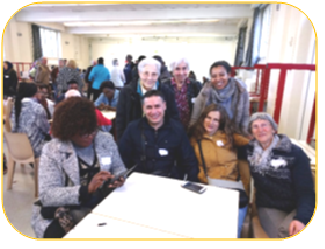 friendship, she was able to overcome the enormous difficulties she faced. She has now obtained her papers and she demonstrated to us all, with great emotion, how grateful she was.
friendship, she was able to overcome the enormous difficulties she faced. She has now obtained her papers and she demonstrated to us all, with great emotion, how grateful she was.
Two Frenchwomen from a small parish explained how the word of the Gospel "Ephata", heard at Mass, led to the creation of a small team of 15 people. They have been looking out for ways to reach out to others and are committed to welcoming and accompanying a family of asylum seekers to their parish. What came over most clearly was all they were gaining from these encounters.
The team had come into contact with young people from a high school to whom they spoke about the migrant situation. They, in turn, wanted to become involved and invited a young migrant to go skiing with them. At Christmas many invited friends and family to celebrate with the migrants and to share what they had been discovering.
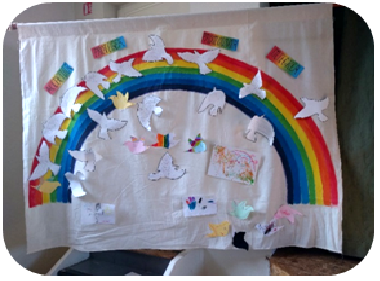
The morning continued with discussions where we shared our experiences of joy despite our frailties. The exchange was very rich and full of simplicity and confidence, thanks to the attentive listening to one another. The children formed their own groups, accompanied by one or two adults.
At the end of the morning, each group read a few phrases remembered from their conversations and wrote them on a dove. These were placed on a huge rainbow, a symbol of our diversity.(see above)
At lunchtime, everyone enjoyed the various dishes prepared by different families and it was a beautifully animated time for dance and celebration.
The day ended with two options: the Eucharist for Catholics and a time of sharing for Muslims. We were surprised to find that some Muslim Kosovars stayed with us for the Eucharist, brothers and sisters of the same Father …together.
Sr Anna and Sr Marie
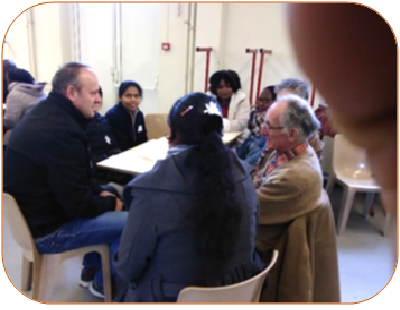
The Catholic Church in the Rhondda
Growth and Decline 1886-2019.
The undulating green hills overlooking the Rhondda Valleys tend to hide a history of coal mining, hard work, suffering but also prosperity in the Rhonda Valley towns. A section of the local cemetery, where the grave stones bear the inscription of so many Irish and Italian names, reminds the visitor of the generations who gave birth to the Church in this region.
The story of one family, told by Sadie, now 93 years old, illustrates a typical history of how the Irish came to Tonypandy back in the 1880’s. Her grandfather died young leaving her grandmother to work a farm and care for her four children. She was unable to make enough money to pay the rent on this farm so she was evicted from her home. She took her youngest child James, Sadie’s father, with her and moved in with her brother to work on his farm. The other children were cared for elsewhere.
James grew up and at the age of 24 decided to go to Wales to find work. On the boat he met a man who said there was plenty of work in Tonypandy in the mines so the two travelled on together. At that time it was usual for families to take in lodgers to boost their income so James lodged with a family and went to work in the local coal mines. At that time there was no Catholic Church but a priest came from Cardiff to say Mass in a public house about four miles from Tonypandy.
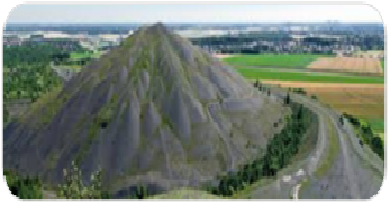
Terril: Mine cuttings
Eventually, Cardiff Diocese bought a plot of land in Tonypandy and the Irish men, after a hard day’s work in the mines, set about fetching stones from the quarry and building the Church. It was opened in 1886 thanks to the hard work of the volunteers who were mostly Irish.
James married a Welsh girl who became a Catholic and they had four children, Sadie being one of them. She remembers her mother cleaning and scrubbing the Church floor on her knees. The Church was then heated by an open coal fire. Sadie, like her mother, continued to clean the Church in her day and at present Sadie’s daughter, now about 65, with two other ladies continue the good work.
The Church is now carpeted, re-decorated and centrally heated. There will not be a next generation of this family to take over as the young people, like so many others, have left the valleys to find work.
The first priest in Tonypandy was a Fr. Bray and he was succeeded in 1894 by Fr. Griffiths. People were poor and were not able to support a priest. Fr. Griffiths died of malnutrition despite the fact that local people, mostly non-Catholics, often gave him a bowl of soup knowing that he, in turn, frequently gave what he had to poor families. However, as the years went by and the Congregation grew, both the town and Church profited from the miner’s incomes.
In the 1920’s two other churches were built in the Rhondda valleys, Treorchy and Ferndale but when, in the 1960’s the mines closed, congregations grew smaller and these two churches were also closed, much to the regret of the local people.
Tonypandy survived partly because it was attached to the one Catholic Primary School. By 2016 there was no resident priest to say Mass so the Bishop asked for two Sisters to help out. Now a visiting retired priest comes at week-ends to say Mass and two Sisters, Berenice and Joanna have moved into the Presbytery to care for the spiritual needs of the people -particularly the sick and housebound. It is very rewarding work to be able to bring Holy Communion and some comfort to people whose ancestors kept the faith alive in this area for one hundred and fifty years,
About one hundred people attend Mass every week-end. Many are from the Philippines who work in local hospitals and have young families. The Welsh/Irish/Italian parishioners are generally retired people.
The Italians also made a great contribution towards the Church in the Rhondda Valleys - but theirs is another story which is very well worth recording.

Dreams and Reality
Life in a Parish
When I returned to the English Province after my term as General Secretary, I fondly dreamed that I would have more time for prayer and time to write – time to be! It was a dream but certainly not reality, for I very quickly found myself immersed in parish life with its many different challenges.
Nearly five years ago, Sr Maureen Davies and I moved into the presbytery at Blessed Sacrament, Rumney, Cardiff which had become vacant on the death of the parish priest. Sr Maureen would continue her work as the Administrator of the Diocesan Pastoral Centre while I would work in the parish since there was no longer a resident priest – we are served from the neighbouring parish of St John Lloyd about a mile and half away.
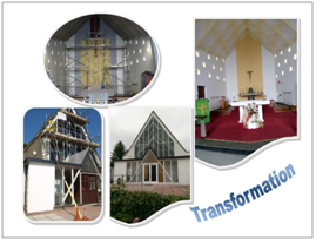
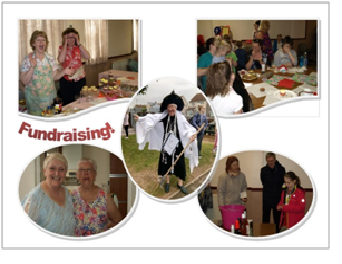
The house had been refurbished before our arrival but little or no work had been carried out on the Church for about 30 years – it was leaking, badly in need of renovation and the furnishings and altar linen were quite literally rotting away because of the damp. The first task was to set up a Parish Action Group who would share in the many tasks which needed to be done – planning, cleaning, fundraising etc. in other words taking ownership.
The parish has the largest Traveller Site in Europe with housing for around 2000 Travellers who claim Blessed Sacrament as their parish. Irish Travellers are a traditionally itinerant ethnic group who maintain a set of traditions. They live mostly in Ireland as well as ass comprising large communities in the United Kingdom and USA. There is also a fairly large Indian community mostly from Kerala, as well as other ethnic groups – Filipinos, Africans, Poles and Italians, all very well integrated into parish life.
The parishioners are very generous and the Parish Action Group work together to bring life to the parish. As a group we have been very inventive in ways of fundraising, (greatly needed), and at the same time developing a deeper sense of community, where people really do look out for one another in times of joy and sorrow. One of our first fundraising efforts was a sponsored “Toddle” – we couldn’t run – some of us couldn’t even walk but we did “toddle” round the 2km trail on zimmers (walking frames) and sticks while I arrived as the White Witch and went around on a broomstick!
The church building is now watertight; it has been painted inside and out and looks welcoming and cared for. Thanks to the generosity of our Sisters, much of the linen and altar furniture has been replaced and all this has enabled us to make the building a more worthy place in which to worship. Again, thanks to our Sisters we have a beautiful set of Easter garden figures. It isa far cry from our first Easter here when we pasted over the rotting plaster with coloured paper decorated with Easter symbols, just to give some sense of Easter joy!
But although I sometimes felt, in the early days, I had become a site manager, a scaffolding expert, a tree feller and a painter and decorator, life has been about much more than that. The building is only a means to an end: that of sharing the love of God with those we meet and providing time and space for people to deepen their prayer life.
Two very special ventures have been our annual Advent Carols by Candlelight and our monthly Exposition of the Blessed Sacrament with Mass and a soup lunch, each First Friday. Advent Carols began very small but we now have around 100 people coming andour parish primary school of St John Lloyd, has provided us with a choir, forging strong links between the parish and the school and the homes.
Last summer we had the joy of the ordination of one of our parishioners and we went in force to the Cathedral for the ceremony and the next day our church was packed for his first Mass. It was a very special occasion - one which really brought out the best in people. They were determined that it would be something to remember for a long time and worked so well together to make it that way.
Catechesis for the sacraments is carried out jointly with St John Lloyd parish and one of the blessings has been that of enabling lay people to feel confident enough to share their faith. Catechists from both parishes are beginning to take on responsibility themselves. Our core group has become the support group for the RCIA (Rite of Christian Initiation of Adults) programme and lately has transformed into a faith sharing group and the beginnings of evangelisation – not always a popular word! We have also trained several parishioners as Eucharistic ministers for the sick and housebound and now this ministry is largely carried out by them.The seeds are being sown and all we can hope is that through the grace of the Spirit each little seed will add something to the growth of faith.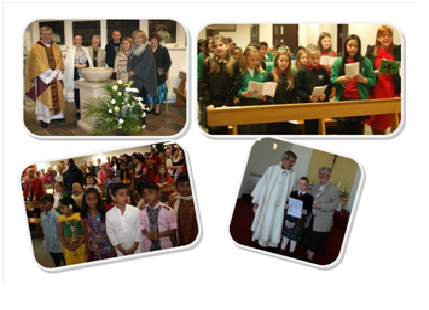
In the last two or three years, I myself have been trained as a Lay Minister for Funerals – a new concept in our Archdiocese. This is a privileged ministry at a time when people are very vulnerable. Sadly I find so often that while the deceased may have been a practising Catholic, the next generations are mostly not church attenders and have little idea of the religious aspect of death. It is a challenge to reach out to them as, for many, this may be one of the few occasions when they have contact with anything religious.
Another big demand is the presence of the large Travelling community. Their understanding of faith and practice is certainly expressed differently, although we have successfully integrated the young people into both the Confirmation and First Holy Communion programmes. The parents come themselves for the Baptism preparation programme but, as many are not literate, we do have to stress that there is no written work – it’s mostly DVD and discussion. There have some challenging situations atTraveller funerals and weddings, when rival groups have begun fighting. There was one notorious funeral when there were armed police and a police helicopter at the cemetery and it even made the national TV news!
I have been involved in education in one way or another for much of my life and I love the contact with the school and the children through my work as a school governor for St John Lloyd School. It is another great way of contributing to the Catholic ethos of the school which has just received a glowing report after a recent inspection. My role there helps to strengthen the partnership between church and school, to give support to the staff and is a good way of getting to know families.
What happened to my dream? I think my dream has become reality - but not in quite the way I expected! I have had the privilege of working with and for so many wonderful people who have allowed me into their lives to share with them the riches of our charism, in the good times and the not so good. I have tried to give but I know I have received so much in return. I love what I do- it is often hard and demanding, but it is also what dreams are made of.
“We go by preference to the poor and most neglected and we seek to form apostles who will continue to spread the Gospel message that all are called to the greatest love.” (Constitutions 39)
It would be wonderful to hear how this is lived out in other parts of our SSJ world.
Sr. Marie De Montfort

News from the English Province
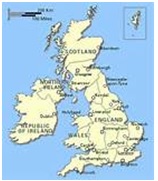
Some reflections on what God is revealing to us today through Creation.
Sr. Bridget Pritchard from the English Province, is a member of both the Ty Croeso Retreat Centre team and the Province’s JPIC Commission. She also works with various parish and school groups and with Christians of other denominations. During the last two years she has shared her insights on Creation Spirituality by posting several articles on Facebook. Here are two of these reflections of what God is revealing to us in Creation.
The locust
 As a pupil in school I became quite alarmed one day to find the locusts in the cage hanging from their branches, dead. I was assured that they were not dead but what I perceived to be a dead animal was in fact its empty shell that it had outgrown.
As a pupil in school I became quite alarmed one day to find the locusts in the cage hanging from their branches, dead. I was assured that they were not dead but what I perceived to be a dead animal was in fact its empty shell that it had outgrown.
It seems that locusts have an exoskeleton. Unlike us, locusts have their skeletons on the outside and wear it like protective armour. There is an obvious advantage to this, though there is also a definite disadvantage.
Living inside this hardened case means that
growth becomes difficult. In order for the animal to grow it has to shed this armour. This leaves the animal very vulnerable to predators until its new shell has hardened. The animal has to let go of its security if it wishes to grow. In fact, there is no choice- it’s ‘grow or die’.
For me, this speaks of my image of God. I can hold on to the image I had as a child even though it is no longer helpful, no longer fits with what I knownow. I need the courage to let it go. This leaves me feeling vulnerable
A thought
In Laudato Si Pope Francis says....
“……If we want to bring about deep change, we need to realize that certain mind sets really do influence our behaviour. Our efforts at education will be inadequate and ineffectual unless we strive to promote a new way of thinking about human beings, life, society and our relationship with nature.” (L Si 215)
This calls me to step out into the unknown. To let go and let the new emerge.It feels like attempting to walk on water and trusting that God is there.And God is there. This is the certainty amongst all the uncertainties, the unchanging amongst all the changes. God is the good parent – supporting me in my growth. This is my security. I listen to the words, “Do not be afraid”. This enables me to let go and feel the vulnerability. This feeds my relationship with God and others. This is where I am alive, this is where I grow.
How does this speak to you today?
Caterpillars and Butterflies
Most people know that caterpillars become butterflies. I taught this for many years and I would try and imagine which bit of the caterpillar became the equivalent part of the butterfly. I would never have imagined what is coming to light now.
We are told that as the transformation from caterpillar to butterfly begins, all structures disintegrate to make a kind of creative soup in the chrysalis. New and different cells emerge in this soup. These are known as imaginal cells because they hold an image of what the butterfly – the new life, will be like.
To begin with, the caterpillar cells regard the new cells as aliens, intruders and destroy them. But the new cells continue to appear in greater and greater numbers until they overwhelm the defence system of the caterpillar. The old order is gone and the butterfly emerges triumphant. This change from caterpillar to a butterfly is a powerful metaphor for the transformation of society.
Some people in society are like these imaginal cells. They see the possibility of something new and wonderful happening. They carry in them a vision or image of a better world.
Initially they are seen as a problem, disturbers of the present, destroyers of the old society which had always been seen as ‘the good life’ even though it no longer works and was never ‘good’ for everyone. The immune response of the old society is to get rid of them. But the imaginal individuals keep coming. They get together in groups as they find this is a more efficient way of bringing the new life.
A thought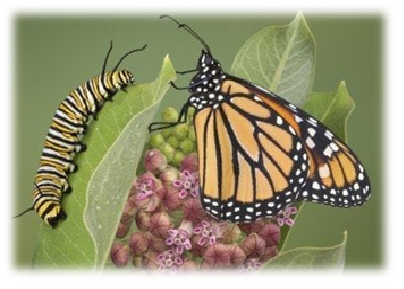
I can see chaos around me but how do I respond?
I can complain and become dis-empowered with a sense of hopelessness or I can see this as a symptom that the old order is collapsing and waiting to be transformed into new life.
One of the most powerful ways to help bring about change is to identify the imaginal individuals in society and support them. If I want to be a part of a different world where love and compassion are paramount then I am an imaginal cell too.
To be part of this life giving movement I need to…
ü really want it;
ü believe that it will happen;
ü make choices that will bring the idea to birth.,
ü use my intelligence and all my other gifts to bring it about.
A sure sign of something good is happening when results are achieved against all the odds.
We are part of Gods ongoing creation and God is waiting to work through us. All over the world people are having similar thoughts, desires wanting to make a difference and we can make links and support them.
There will be real change when we know in our hearts that we are one, and everythought, feeling, word and deed affect the whole. I am one part of a sacred web of interconnection and creativity.
What am I waiting for?
Where do I see the signs of new life and how do I support it?
What transformation is waiting to happen in me?
Prayer of becoming
Godof new creation
On the journey from caterpillar to butterfly
keep us faithful to that soupy stage
when structures fall apart.
When we have lost sight of who we were
and cannot yet grasp
who we are to become,
give us courage to keep going.
Strengthen our confidence,
that the new thing
you desire to do in us
and through us will be full of your glory. Amen
(Rachel Parkinson, Wolverhampton and Shrewsbury District Chair)
- the Methodist equivalent of Bishop


